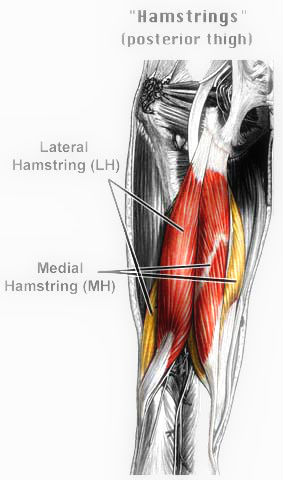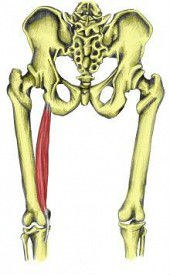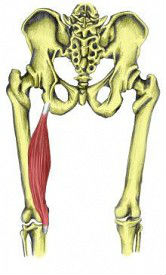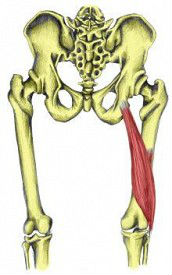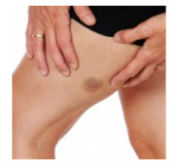A hamstring strain or a pulled hamstring
A hamstring strain or a pulled hamstring as it is sometimes called is a tear in one or more of the hamstring muscles.
Strictly speaking there are three hamstring muscles (Semitendinosus, Semimembranosus and Biceps Femoris) which are known as the hamstring muscle group
The role of the hamstring muscles is to bend (flex) the knee and to move the thigh backwards at the hip (extend the hip). Understanding how the hamstrings work give vital clues as to their modes of injury. Mild to severe hamstring strains are extremely common in sprinters and hurdle jumpers and in all sports that involve sprinting activities, such as football and rugby.
During sprinting the hamstring muscles work extremely hard to decelerate the tibia (shin bone) as it swings out. It is in this phase just before the foot strikes the ground that the hamstrings, become injured as the muscles are maximally activated and are approaching their maximum length.
A pulled hamstring rarely manifests as a result of contact -if you have taken an impact to the back of the leg it should be treated as a contusion until found to be otherwise.
Severity of a Pulled Hamstring
Strains are graded 1, 2 or 3 depending on severity.
Grade 1 consists of minor tears within the muscle. A grade 2 is a partial tear in the muscle and grade 3 is a severe or complete rupture of the muscle.
Grade 1
- May have tightness in the posterior thigh.
- Probably able to walk normally however will be aware of some discomfort.
- Minimal swelling.
- Lying on front and trying to bend the knee against resistance probably won't produce much pain.
Grade 2
- Gait will be affected - limp may be present.
- May be associated with occasional sudden twinges of pain during activity.
- May notice swelling.
- Pressure increases pain.
- Flexing the knee against resistance causes pain.
- Might be unable to fully straighten the knee.
Grade 3
- Walking severely affected - may need walking aids such as crutches.
- Severe pain - particularly during activity such as knee flexion.
- Noticeable swelling visible immediately.
Treatment of a Pulled Hamstring
What can the athlete do?
It is vitally important that treatment for a pulled hamstring starts immediately following injury. The most important phase for treatment is the first 48 hours post-injury. In this time the following can be carried out by the athlete themselves:
- Use Cold Therapy (Rest, Ice, Compress, Elevate) technique.
- Use a compression bandage to minimize intra muscular bleeding.
- Early mobilization of the injured lower limb is vital for the correct rehabilitation of the muscle. This includes stretching and strengthening exercises throughout the pain free range. These can aid with decreasing the swelling in the area. In addition, exercise will ensure that any new material will be laid down in correct orientation thus reducing the risk of subsequent injuries.
- See a sports injury specialist.
What can a Sports Injury Specialist do?
- Use sports massage for hamstrings to speed up recovery. Sports massage is important in the treatment and rehab of hamstring muscle injuries as massage helps correct new muscle fiber realignment and minimizes scar tissue. In addition massage can increase the blood flow to the injured area.
- Use ultrasound and other forms of electrotherapy.
- Prescribe a rehabilitation program.
- Advise on specific stretches.
- Provide mobility aids such as crutches.
- Provide an MRI scan to ascertain the amount of damage sustained.
- In severe ruptures surgery may be needed to repair the damage
Semitendinosus
When running the hamstrings act eccentrically to slow down the knee extension motion. Hamstring strains are common in individuals with chronically tight hamstrings or who do not warm-up thoroughly.
Origin
- Ischial tuberosity.
Insertion
- Upper medial surface of the tibia.
Actions
- Hip extension.
- Knee flexion.
- Internal rotation of the hip when the knee is flexed.
Innervation
- Tibial part of the sciatic nerve.
Daily uses
- Bending the knee to step over something.
Example strengthening exercises
- Knee curl machine.
- Hip extension using a resistance band.
Example stretches
- Sitting hamstring stretch.
- Standing hamstring stretch.
- Partner hamstring stretch.
Related injuries
- Hamstring strains.
- Hamstring tendinitis.
Related muscles
- Semimembranosus.
- Biceps femoris.
Semimembranosus
Semimembranosus is the most medial of the three hamstring muscles. Chronically tight hamstrings are often a contributary factor to lower back pain and knee pain.
Origin
- Ischial tuberosity.
Insertion
- Posterior part of the medial condyle of the tibia.
Actions
- Hip extension.
- Knee flexion.
- Internal rotation of the hip when the knee is flexed.
Innervation
- Tibial part of the sciatic nerve.
Daily uses
- Bending the knee to step over something.
Example strengthening exercises
- Knee curl machine.
- Hip extension using a resistance band.
Example stretches
- Sitting hamstring stretch.
- Standing hamstring stretch.
- Partner hamstring stretch.
Related injuries
- Hamstring strains.
- Hamstring tendinitis.
Related muscles
- Semitendinosus.
- Biceps femoris.
Biceps Femoris
Biceps Femoris is one of the three muscles which form the hamstring group forming the back of the thigh. The muscle is often described as having a long head (the attachment from the ischium) and a short head (attached to the femur).
Origin
- Tuberosity of the ischium.
- Lower 1/2 of the linea aspera of the femur.
- Lateral supracondylar ridge.
Insertion
- Lateral condyle of the tibia.
- Head of the fibula.
Actions
- Hip extension.
- Knee flexion.
- Lateral rotation of the hip when the knee is flexed.
Innervation
- Tibial part of the sciatic nerve.
Daily uses
- Bending the knee to step over something.
Example strengthening exercises
- Knee curl machine.
- Squat.
- Leg press machine.
Example stretches
- Standing hamstring stretch.
- Sitting hamstring stretch.
- Partner hamstring stretch.
Related injuries
- Hamstring strain.
Related muscles
- Semimembranosus.
- Semitendinosus.
Hamstring Muscle Contusion
A hamstring muscle contusion involves a direct blow to the back of the thigh causing the muscle to be crushed against the bone.
Symptoms
- Pain at the site of injury.
- There may be swelling or bruising.
- Restricted movement is not uncommon.
After two to three days check:
- If the swelling has not gone then the athlete probably has an intramuscular injury.
- If the bleeding has spread and caused bruising away from the site of the injury then they probably have an intermuscular injury.
- If they are more able to contract the muscle then an intermuscular injury is suspected.
- Is there a deformation in the muscle or a gap?
It is important the correct diagnosis is made because trying to exercise on a complete rupture, or a bad intramuscular injury can inhibit healing, make things worse or cause permanent disability. If heat and massage is applied in the early stages then Myositis Ossificans (or bone forming within the muscle) may result.
Like muscle strains, contusions are grade 1, 2 or 3 depending on the severity.
What is a Contusion?
This type of hamstring injury is very common in contact sports. An impact to the muscles can cause more damage than might be expected and should be treated with respect. The muscle is crushed against the bone. If not treated correctly or if treated too aggressively then myositis ossificans may result.
Intramuscular and Intermuscular Contusions
Intramuscular which is a tearing of the muscle within the sheath that surrounds it. This means that the initial bleeding may stop early (within hours) because of increased pressure within the muscle however the fluid is unable to escape as the muscle sheath prevents it. The result is considerable loss of function and pain which can take days or weeks to recover. There is not likely to be any bruising with this type - especially in the early stages.
Intermuscular which is a tearing of the muscle and part of the sheath surrounding it. This means that the initial bleeding will take longer to stop especially if cold therapy or ice is not applied. However recovery is often faster than intramuscular as the blood and fluids can flow away from the site of injury. There is more likely to be bruising with this type of injury.
Treatment for a Hamsting Contusion
Contusions are graded 1,2 or 3 depending on severity of injury:
Grade 1
What does it feel like?
- Might have tightness in the back of the lower leg.
- May be able to walk properly.
- Probably won't have much swelling.
- Nearly a full range of motion.
What can the athlete do?
- Rest.
- Apply ice or cold therapy, Compress and Elevate (R.I.C.E.) immediately.
- See a sports injury professional for advice on treatment and rehabilitation.
What can a Sports Injury Professional or Doctor do?
- Use sports massage techniques to speed up recovery (very important).
- Use ultrasound and electrical stimulation.
- Prescribe a rehabilitation programme consisting of stretching, strengthening and sports massage techniques.
Grade 2
What does it feel like?
- Probably cannot walk properly.
- Occasional sudden twinges of pain during activity.
- May notice swelling.
- Pressing in causes pain.
- Contracting the hamstring muscles against resistance causes pain.
- May have limited range of movement.
What can the Athlete do?
- Ice, compress, elevate, use crutches for 3 to 5 days.
- See a sports injury professional who can advise on treatment and rehabilitation.
What can a Sports Injury Specialist or Doctor do?
- Use sports massage techniques to speed up recovery (very important).
- Use ultrasound and electrical stimulation.
- Prescribe a rehabilitation programme.
Grade 3
What does it feel like?
- Unable to walk properly without the aid of crutches.
- In severe pain.
- Bad swelling appears immediately.
- A static contraction will be painful and might produce a bulge in the muscle.
- Expect to be out of competition for 3 to twelve weeks.
What can the athlete do?
- Seek medical attention immediately.
- R.I.C.E. (Rest, Ice, Compress, Elevate.)
- Use crutches.
- See a sports injury professional who can advise on treatment and rehabilitation.
What can a Sports Injury Specialist do?
- Use sports massage techniques to speed up recovery (very important).
- Use ultrasound and electrical stimulation.
- Prescribe a rehabilitation programme and monitor it.
- Operate if needed.
SPORTS INJURY CLINIC and Sports Injury Bulletin
http://www.sportsinjuryclinic.net/ http://www.sportsinjurybulletin.com/archive/hamstring.php
See also:
»Newer topics:
»Older topics:
»
![]() A pain in the Bum
A pain in the Bum
Pain in the ischium due to - "ischial tuberosity" that is a swollen part or broadening of the bone in the frontal portion of the ischium
![]() A pain in the Bum
A pain in the Bum
Pain in the ischium due to - "ischial tuberosity" that is a swollen part or broadening of the bone in the frontal portion of the ischium


